Use the below code to get the waveform like ios... get the amplitude from the recorder and pass to updateAmplitude() function to get the variation in voice.
public class WaveFormView extends View {
private static final float defaultFrequency = 1.5f;
private static final float defaultAmplitude = 1.0f;
private static final float defaultIdleAmplitude = 0.01f;
private static final float defaultNumberOfWaves = 5.0f;
private static final float defaultPhaseShift = -0.15f;
private static final float defaultDensity = 5.0f;
private static final float defaultPrimaryLineWidth = 3.0f;
private static final float defaultSecondaryLineWidth = 1.0f;
private float phase;
private float amplitude;
private float frequency;
private float idleAmplitude;
private float numberOfWaves;
private float phaseShift;
private float density;
private float primaryWaveLineWidth;
private float secondaryWaveLineWidth;
Paint mPaintColor;
Rect rect;
boolean isStraightLine = false;
public WaveFormView(Context context) {
super(context);
setUp();
}
public WaveFormView(Context context, AttributeSet attrs) {
super(context, attrs);
setUp();
}
public WaveFormView(Context context, AttributeSet attrs, int defStyleAttr) {
super(context, attrs, defStyleAttr);
setUp();
}
@TargetApi(Build.VERSION_CODES.LOLLIPOP)
public WaveFormView(Context context, AttributeSet attrs, int defStyleAttr, int defStyleRes) {
super(context, attrs, defStyleAttr, defStyleRes);
setUp();
}
private void setUp() {
this.frequency = defaultFrequency;
this.amplitude = defaultAmplitude;
this.idleAmplitude = defaultIdleAmplitude;
this.numberOfWaves = defaultNumberOfWaves;
this.phaseShift = defaultPhaseShift;
this.density = defaultDensity;
this.primaryWaveLineWidth = defaultPrimaryLineWidth;
this.secondaryWaveLineWidth = defaultSecondaryLineWidth;
mPaintColor = new Paint();
mPaintColor.setColor(Color.WHITE);
}
public void updateAmplitude(float ampli, boolean isSpeaking) {
this.amplitude = Math.max(ampli, idleAmplitude);
isStraightLine = isSpeaking;
}
@Override
protected void onDraw(Canvas canvas) {
rect = new Rect(0,0,canvas.getWidth(),canvas.getWidth());
canvas.drawColor(Color.BLUE);
/*canvas.drawRect(rect, mPaintColor);*/
if(isStraightLine) {
for (int i = 0; i < numberOfWaves; i++) {
mPaintColor.setStrokeWidth(i == 0 ? primaryWaveLineWidth : secondaryWaveLineWidth);
float halfHeight = canvas.getHeight() / 2;
float width = canvas.getWidth();
float mid = canvas.getWidth() / 2;
float maxAmplitude = halfHeight - 4.0f;
float progress = 1.0f - (float) i / this.numberOfWaves;
float normedAmplitude = (1.5f * progress - 0.5f) * this.amplitude;
Path path = new Path();
float multiplier = Math.min(1.0f, (progress / 3.0f * 2.0f) + (1.0f / 3.0f));
for (float x = 0; x < width + density; x += density) {
// We use a parable to scale the sinus wave, that has its peak in the middle of the view.
float scaling = (float) (-Math.pow(1 / mid * (x - mid), 2) + 1);
float y = (float) (scaling * maxAmplitude * normedAmplitude * Math.sin(2 * Math.PI * (x / width) * frequency + phase) + halfHeight);
if (x == 0) {
path.moveTo(x, y);
} else {
path.lineTo(x, y);
}
}
mPaintColor.setStyle(Paint.Style.STROKE);
mPaintColor.setAntiAlias(true);
canvas.drawPath(path, mPaintColor);
}
} else {
canvas.drawLine(5,canvas.getHeight()/2,canvas.getWidth(),canvas.getHeight()/2,mPaintColor );
canvas.drawLine(0,canvas.getHeight()/2,canvas.getWidth(),canvas.getHeight()/2,mPaintColor);
canvas.drawLine(-5, canvas.getHeight() / 2, canvas.getWidth(), canvas.getHeight()/2,mPaintColor );
}
this.phase += phaseShift;
invalidate();
}
}


